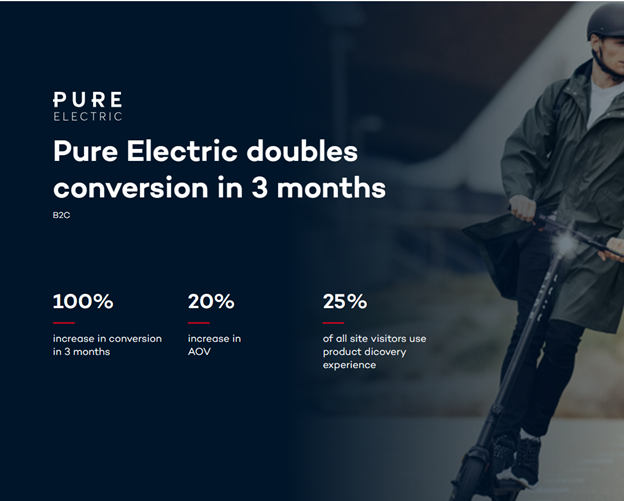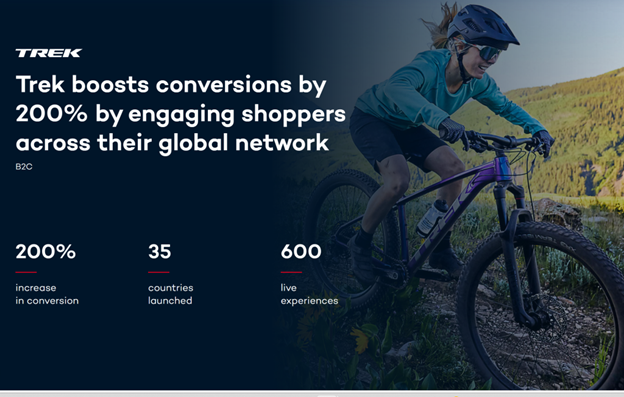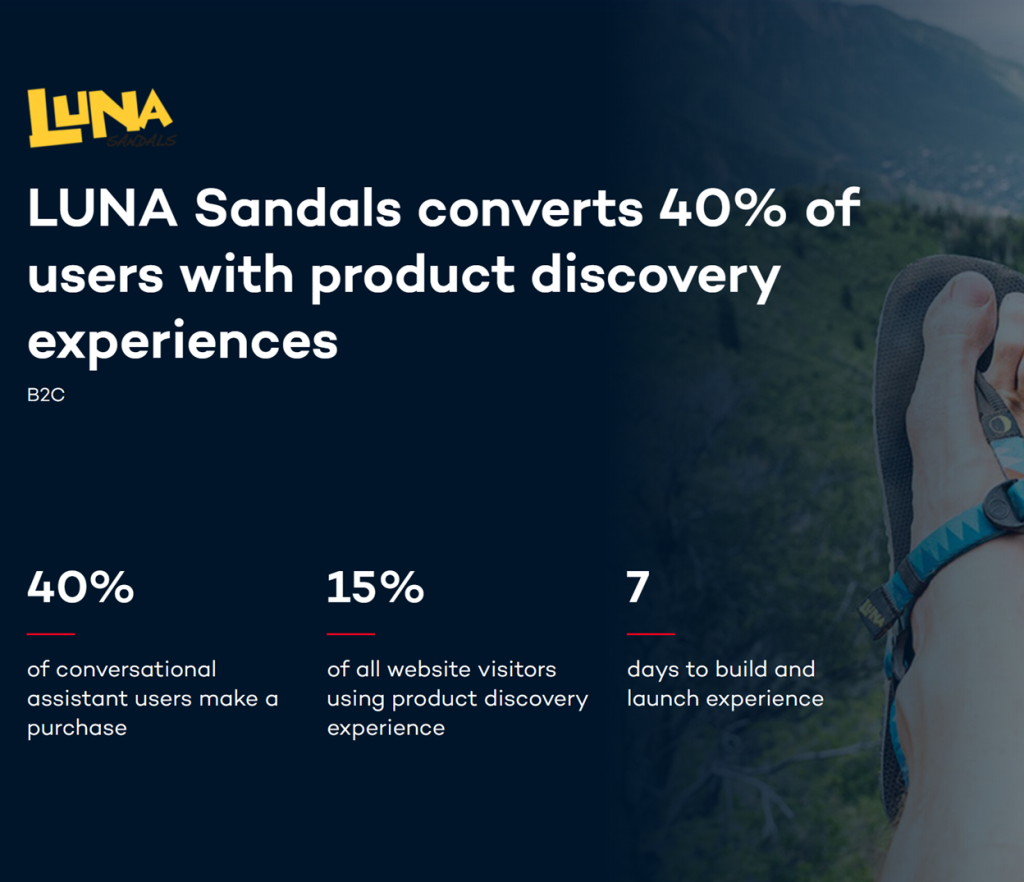Every B2C company has goals such as improving conversions, fueling growth, and scaling success. However, results can be lackluster when product pages aren’t fully optimized.
Product detail page (PDP) optimization is focused on improving results by enhancing critical page elements. These improvements create a more helpful user experience, leading to higher conversions and more sales.
In this post, we’ll explore the best strategies for improving PDP optimization so you can align your page performance with the results you want to achieve.
In ecommerce, your product page is your pitch. Make sure you have a clear value proposition that speaks to your customers’ needs and desires.
– Neil Patel, Digital Marketing Expert
Clear Value Proposition
Customers buy a product to solve a challenge, and it’s the product page’s job to clearly communicate why yours is the best option for achieving that goal. A clear value proposition will help you:
- Speak to a customer’s specific needs. Explain clearly how your product solves each of the customer’s needs and pain points.
- Directly address the audience. Use words that make the product page more personal, such as “you,” and avoid stilted, impersonal language.
- Keep it simple. Make the value of your product immediately apparent to the audience, and avoid jargon.
- Stay consistent. Align your product page with other marketing materials for a consistent branding messaging experience.
Once you’ve defined a clear value proposition, you can capture greater success by mastering needs-based selling and doing so at scale.
Needs-Based Selling
Customers are demanding more personalized and meaningful experiences from the brands that serve them. According to McKinsey, 71% of consumers expect personalization, and companies that excel in this area generate 40% more revenue.
Traditionally, the conversion starts with uncovering needs. Probing questions are asked. Needs are identified. And recommendations are provided.
Conducting this process at scale, however, isn’t always easy.
An AI-guided selling assistant helps you collect information and turn that information into personalized product recommendations in real-time to improve customer satisfaction and increase conversions. For example, Pure Electric is the UK’s leading specialist electric scooter and electric bike retailer, stocking e-scooters, e-bikes, and accessories. After careful evaluation, the company’s analysts determined a clear pattern of users bouncing on product pages, showing that customers weren’t sure which scooter was right for them.

Using an AI-guided selling assistant, the company quickly saw inquiries to customer service drop, the average order value increase by 20%, and a 100% boost in conversions.
This is a prime example of how leveraging needs-based selling at scale helps drive better results.
People remember 80% of what they see and only 20% of what they read.
– Dr. Lynell Burmark, Education & Visual Literacy Expert
High-Quality Imagery
Customers are more likely to remember content that includes an image. Why? Visuals are processed 60,000 times faster than text is.
Use clear, crisp images that showcase your products’ finest details. Offer multiple views of a product, helping your target audience visualize its functionality, and be sure to include images of the product in use. For example, Trek Bicycle, one of the world’s leading manufacturers of cycling products, frequently uses action shots of its products to help customers visualize product use and functionality.
Trek also leverages a product discovery experience that allows the company to match customers with their perfect bikes, based on an AI-driven question-and-answer flow. This experience, supported by high-quality imagery, has allowed the company to experience a 200% increase in conversions.

Pro Tip:
Create a uniform look and feel across all your product images for a cohesive branding experience. Add descriptive alt text to the photos to improve your content’s accessibility, and you will be rewarded by search engines!
Lastly, since many of your shoppers are on the go, ensure that images are optimized for a mobile experience. Here are a few more recommendations to consider when choosing your images:
Feature Original Product Photography
Don’t settle for generic, manufacturer-supplied images that customers encounter everywhere. Stand out by featuring original, lifestyle-oriented photography that aligns with your brand’s unique vision. Imagine showcasing a KitchenAid Mixer not just on a sterile countertop but in a family kitchen during Sunday brunch. Picture your fashion apparel not on faceless mannequins but on individuals embodying the lifestyle your customers aspire to—casual or elegant.
How about thinking beyond the product? Feature it in use during a camping adventure, a city commute, or a workout session. These context-rich visuals captivate your audience, resonate with their aspirations, and elevate their shopping experience, thereby driving engagement and boosting conversions. For a product page generating tens of thousands of impressions, make yours count!
Offer Real-Time Customizations
Support new customers with visualizing how a product will solve their challenges by offering deeper personalization. Enable them to customize colors, sizes, and additional attachments and features so that they can become truly invested in the shopping experience by creating a product that is uniquely theirs.
Enable 3D Rotation
While physically holding a new product isn’t possible with online shopping, you can get close. Customers have many questions when considering a purchase, including: How does it look from the other side? How does it look from the top? Enabling rotation with a tool like a 3D product configurator helps answer these questions.
Showcasing unique product features and providing a more comprehensive shopping experience also fosters the confidence required to take that next logical step toward making a purchase.
View the Product in AR or VR
Ordering a product is a risk. What if you don’t like it? What if it doesn’t work as expected? What if you’re disappointed? These types of questions become roadblocks in the path to purchase.
Augmented reality (AR) and virtual reality (VR) help clear the path. Through a customer experience similar to being there in person, customers understand the purchase in context, feeling greater buying confidence.
Social Proof: The Storytelling Advantage
Transforming a customer from a shopper to a buyer isn’t merely a transaction; it’s a narrative journey that hinges on trust. Steve Jobs once said, “The most powerful person in the world is the storyteller.” In ecommerce, the storyteller is the brand that effectively uses social proof to build credibility.
Reputation, ratings, and reviews act as the chapters of your story, each contributing to a compelling narrative that assures customers they are making the right decision. Through real-world testimonials, ratings, and accolades, you not only provide evidence of product quality but also craft a persuasive story that resonates with buyer intent.
Eighty-seven percent of buying decisions start with online research. As customers decide whether they can trust your products and brand, they turn to ratings and reviews. But what’s the difference?
Ratings
Ratings are quantitative and include a numeric value. A product with a 4.5-star rating, for example, might capture a customer’s attention, enticing him or her to dig further and read customer reviews.
Reviews
Reviews come in various forms, each with its own value proposition to offer. Some reviews are brief but impactful, offering quick, specific insights that address immediate concerns. Comments like “These running shoes are true to size” or “The jacket ran a size small; order a bigger size than you might normally take” provide immediate guidance. These reviews assist buyers in making rapid decisions, clearing any initial hesitations regarding size or fit.
On the other end of the spectrum are the in-depth, real-world reviews that serve as mini-guides for potential buyers. Consider the following review on a pair of Adidas running shoes:
I have been training for my first marathon while wearing these. I have worn other Adidas runners in the past and generally been pleased. These are definitely the best pair though. They are lightweight and breathe well. My feet are always dry at the end of long runs, and I don’t have any blisters or soreness due to the shoe. So far I’ve put over a hundred miles on them and they aren’t showing any signs of wear outside getting a little dirty. I think I will stick with this model shoe from now on in future purchases.
This review revealed some incredible insight about the product:
Real-World Testing: The reviewer has been training for a marathon, providing context that these shoes can withstand intense, long-term use.
Comparative Analysis: The reviewer has experience with other Adidas shoes, giving credence to their claim that this particular model is superior.
Detailed Insights: From breathability to durability, the review covers multiple facets of the product, offering a holistic view.
Post-Purchase Satisfaction: The reviewer’s intent to repurchase the same model underscores the product’s quality and their satisfaction level.
Such in-depth reviews weave a comprehensive story around the product, assisting shoppers in making informed and confident purchase decisions. These comprehensive reviews not only elevate the buying experience but also offer valuable insights that can be leveraged for product discovery.
At Zoovu, we help enterprise ecommerce teams use the power of AI to capture and analyze user-generated content across thousands of products. Our AI tool scans these reviews, extracts relevant insights, and enriches your ecommerce product data. This streamlined approach allows us to transform subjective experiences into actionable data to optimize the customer experience from discovery to purchase.
Businesses should always be focusing on driving operational efficiency whilst improving the customer experience and journey. Zoovu does this and more. It’s a no-brainer decision.
Consumers don’t want to turn over a purchase decision to just anyone; they want to feel as if they are making an informed decision.
– Brian Solis, Digital Analyst
Detailed Product Description
A detailed product description gives your customers everything required to take the next step confidently. The goal is to remove any doubts and clear the path to purchase.
A description should be accurate and include information that answers a customer’s potential questions. An effective way to accomplish this is with product data enrichment.
Product Data Enrichment
Product data enrichment helps enhance and refine raw data, making it more accurate and valuable to your customers’ shopping experiences. A few ways to leverage it are:
Feature-Based Data. Manually train your data algorithm using sample product groups. AI can be used to apply classification to similar products based on their attributed values.
Description-Based Data. Dive into your existing product descriptions and marketing content to uncover deeper meanings and enrich your content.
Review-Based Data. Scrape user-generated content to enhance product information data and gain a better understanding of your customers’ preferences and experiences.
Generative AI Product Classifier. Use generative AI and large language models to classify, score, and describe your products automatically.
Need help transforming your product data into a profitable digital sales experience?
Businesses should always be focusing on driving operational efficiency whilst improving the customer experience and journey. Zoovu does this and more. It’s a no-brainer decision.
Personalization is not a trend; it’s a marketing tsunami.
– Avi Dan, Marketing Consultant.
Personalization
Customers want to feel known in the moment of relevance, so much that 80% report they’re more likely to purchase from a company offering personalization. Forty-four percent report they’re likely to become repeat buyers after a single personalized shopping experience.
So here’s the question: Are your product descriptions personalized?
That’s where a guided selling assistant can help.
Customers often feel overwhelmed when purchasing a new product. Without a clear, easy path to finding the right product, indecision sets in, and then inaction. A guided selling assistant provides personalized product recommendations at scale.
Here’s a case study and an example to consider. LUNA Sandals struggled with confused customers, high drop-off rates, and lost sales opportunities. The company understood it needed to provide potential customers with self-service solutions that would educate them in choosing the best product for their needs.

Building and launching the experience took 7 days. After rolling it out, the company found that 40% of conversational assistant users make a purchase.
Intelligent Recommendations
Browsing history is a window into a customer’s likes, dislikes, and future needs. With Amazon pioneering the “you may also like” recommendations, customers are accustomed to and expect personalized suggestions.
Using data analytics and machine learning, you can offer personalized product suggestions based on user history before purchase, and even similar customer profiles.
With a platform like Zoovu, you don’t need to rely on third-party data. By incorporating guided selling assistants, configurators, or an AI search engine on your site, you can gain zero-party insights to take your personalization to a new level.
Zoovu’s AI-powered product recommendation engine can automate personalized recommendations at scale.
Personalization Example
A customer lands on your ecommerce site, searching “blue women’s winter jacket.”
The customer clicks on the product detail web page, viewing a “You may also like…” section.
The “You may also like” section dynamically updates to show winter accessories like gloves, hats, and scarves that pair well with the viewed jacket.
The personalized engine can prioritize showing items in the customer’s size or preferred color, avoiding the disappointing experience of finding that perfect item only to learn it’s out of stock.
By incorporating personalized strategies like these into your PDP optimization, you not only enhance user engagement but also increase the chances of upselling and cross-selling, resulting in maximizing order value.
Mobile Responsiveness
Most Americans are shopping online, with research showing that three-quarters report using a smartphone to make a purchase. And it’s even more common for those under 50, according to the same research. So, how do you create more friendly mobile device experiences? A few options are:
Speed up page loading time. Make sure your products load fast and smoothly and that easy transitions exist between your product listings.
Create seamless viewing experiences. Allow your shoppers to swipe through images, and provide pinch-to-zoom capabilities easily.
Enable customized experiences. Use a product configurator that allows customers to use drag-and-drop tools to build more customized bundles visually.
Simplify browsing and search. Use behavior, intent, and performance signals to customize search results by affording intelligent search capabilities.
Businesses should always be focusing on driving operational efficiency whilst improving the customer experience and journey. Zoovu does this and more. It’s a no-brainer decision.
Solve your customers’ problems before they have them, and you will create a memorable experience.
– Shep Hyken, Customer Service Expert
Product Questions
Whether a customer is curious about compatibility, has usage questions, or is seeking tips for maximizing the life of a product, delivering detailed answers guides them toward making a confident and informed purchase. Here are a few sample FAQ topics:
How to Use the Product
A customer’s dissatisfaction with a product often stems from not understanding how to use it. Solve this challenge by offering detailed, set-by-step guides and video tutorials, offering customers details about how to successfully use products.
As a starting point, talk with your customer service team. Ask about the most commonly asked questions. Use that information as the basis for creating the most helpful resources.
Compatibility and Requirements
Guide your customers in selecting the most appropriate products by providing compatibility requirements in your FAQs section. Take compatibility a step further by using smarter search capabilities. For example, data enrichment, which automatically cleans, standardizes, and enriches product data for ecommerce, helps match customers to their best product choices.
Shipping and Returns
Amazon transformed customer expectations around shipping and returns. Customers no longer just want free shipping; they want products faster with easier returns. So, whatever your shipping and return policies, set expectations upfront with critical details, such as delivery time estimates, tracking, and hassle-free returns.
Product Warranty Information
A warranty provides customers with peace of mind when purchasing a product. Solidify that confidence with clear instructions about what a warranty covers and how to use it if needed.
Tips for Maximizing Product Life
Trust is earned with product reviews. Earning positive reviews, however, is difficult with spotty product life experiences. Help customers understand how to get the most from their new purchase with expert advice and instructions.
For example, you might recommend that a customer regularly clean and descale their coffee maker. Without this process, the coffee maker could break prematurely, resulting in the customer vocalizing dissatisfaction.
Are Ecommerce Platforms Falling Short on Product Discovery Needs for Brands?
The tips above provide a solid foundation for optimizing your product pages, but how do customers find them?
Many ecommerce processes are falling short, creating a gap between your customers’ needs and quickly finding the product that best serves them. Powerful and intuitive tools help fix this problem, including intelligent search and guided selling.
Intelligent Search in Ecommerce
Intelligent search eliminates the guesswork from customer queries. It leverages behavior, intent, and preference signals to customize search results. Tools such as spell-check and synonym recognition ensure the customer receives the best match to their search query.
Results are supplemented with other helpful resources, such as relevant guides, FAQs, videos, and more, to provide the content that is most relevant to the searcher’s inquiry.
Guided Selling
Buyers have many choices in the market, which makes it challenging to find the right solution. Guided selling solves this problem. It reimagines the conventional sales approach, allowing a shower to communicate their needs and receive instant, personalized recommendations powered by AI.
Behind the scenes, the assistant creates custom question flows to personalize product recommendations and offer complementary items and bundles based on a shopper’s unique behavior.
Businesses should always be focusing on driving operational efficiency whilst improving the customer experience and journey. Zoovu does this and more. It’s a no-brainer decision.
Optimizing a product page is not just about SEO; it’s about creating a seamless and informative experience for the user that naturally leads to conversion. If you focus on delivering value, the rankings will follow.
– Rand Fishkin, Co-Founder of Moz
Bonus Tip: SEO Strategy for Enhanced Product Detail Pages
Nearly half of all customers begin their shopping experience with an online search. Product page SEO is about showing up where your customer is already looking — online.
Improving product page SEO helps increase visibility, increase qualified leads, and support higher conversion rates. There are several ways to enhance your product page SEO, including:
Meta Descriptions
A meta description is a brief summary of your product page. Write a compelling description that includes target keywords to improve click-through rates and drive more traffic to your pages.
Keyword Research
Customers use specific words and phrases to find your products online. Keyword research is about finding them. Identify high-value, long-tail keywords related to your product and incorporate them into your product page titles, headlines, and descriptions.
Alt Text for Images
Images help capture human interest on your product pages, but it’s also important to capture SEO value. Alt text is a brief description of an image on the page. Using alt text supports improved image search rankings and accessibility for those who may use a screen reader.
Schema Markup
Schema markup provides search engines with additional details about your page and helps improve visibility in rich snippets. Increased visibility supports higher click-through rates and website traffic, as well as landing-featured snippets, which receive 35% of total click share.
Social Sharing
Naturally, sharing increases website traffic, but social media backlinks also tell search engines your page is relevant, indirectly influencing SEO rankings. Ensure your product pages have social sharing buttons to make sharing content easy.
***
Millions of shoppers open their browsers daily, with the intent to buy. Leading them to your pages more effectively through PDP optimization helps achieve your goals, whether that’s increasing awareness, improving conversion, or another metric.
However, true optimization requires more than a slick product page. It also requires exceptional buying experiences. It requires personalization.
In the past, achieving personalization required years of building product discovery tools or piecing together disconnected software. But that’s changed. You can now leverage platforms by adding intuitive tools for data enrichment and experience building, which is where customer insights live together. This capability makes it much easier for your customers to buy online, allowing you to sell more, scale faster, and create sustainable growth.
If you want a more effective way to understand your customers in context, check out a product discovery platform such as Zoovu. Request a demo.

